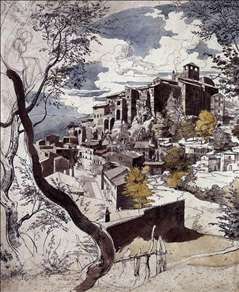German painter. He received his first instruction in art from his father, Conrad Horny (1764-1807), a painter and copperplate engraver, who taught at the Zeichenschule in Weimar. He attended this school from 1806 to 1816, training primarily as a painter of landscapes. In 1816, his patron Baron Carl Friedrich von Rumohr, a friend of his father, enabled him to travel to Italy.
In Rome Horny became a student of Joseph Anton
Koch, who introduced him to landscape composition in the classically heroic style. Through eager study, both from nature and from live models, Horny’s skills developed swiftly, especially in his work in pen and watercolour (e.g.
View of Olevano, 1822; Staatliche Museen, Berlin). Horny was soon, however, drawn into the circle of the Lukasbrder: Peter Joseph
Cornelius persuaded him to participate in the major fresco project for the Casino Massimo in Rome. Horny completed a large number of pen and watercolour drawings (e.g. Weimar, Schlossmuseum) depicting flowers, fruit and birds, and intended as wreaths and festoons to frame Cornelius’s historical scenes from Dante’s Paradiso. When
Cornelius was recalled to Munich in 1818, however, this fresco was not carried out and Horny’s designs were therefore not used. In the same year, Horny developed tuberculosis and moved to Olevano for his health.
The rugged beauty of the Sabine Hills and their picturesque towns drew him back to the depiction of landscape. His drawings, combining Koch’s classically heroic outlook with the poetic sensibility of the Lukasbrder, often convey the impression of an earthly paradise, as in Italian Country Life (c. 1820; Lbeck, St Annen-Museum). In his sketchbooks (e.g. Weimar, Schlossmuseum; Hamburg, Kunsthalle) and magnificently composed watercolours (e.g. Wrzburg, Wagner-Museum; Heidelberg, Kurpfälzisches Museum; Dsseldorf, Kunstmuseum), he may be seen as one of the principal exponents of the German school of landscape painters working in Italy. His watercolour Rome in the Renaissance (1821; Heidelberg, Kurpfälzisches Museum) attests to his experiments in history painting.
